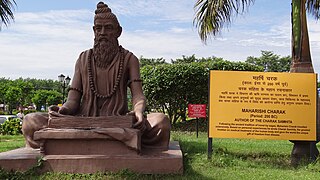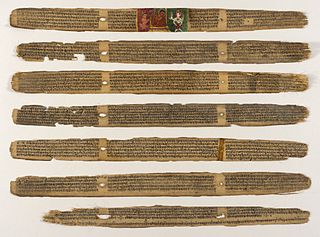Related Research Articles

Ayurveda is an alternative medicine system with historical roots in the Indian subcontinent. The theory and practice of Ayurveda is pseudoscientific. The Indian Medical Association labels Ayurvedic practitioners who claim to practice medicine as quacks. Ayurveda is heavily practiced in India and Nepal, where around 80% of the population report using it.
Vāgbhaṭa (वाग्भट) is one of the most influential writers, Scientist, Doctor and advisor of ayurveda. Several works are associated with his name as author, principally the Ashtāṅgasaṅgraha (अष्टाङ्गसंग्रह) and the Ashtāngahridayasaṃhitā (अष्टाङ्गहृदयसंहिता). The best current research, however, argues in detail that these two works cannot be the product of a single author. Indeed, the whole question of the relationship of these two works, and their authorship, is very difficult and still far from solution. Both works make frequent reference to the earlier classical works, the Charaka Samhita and the Sushruta Samhita. Vāgbhaṭa is said, in the closing verses of the Ashtānga sangraha to have been the son of Simhagupta and pupil of Avalokita. He was a Buddhist, as is shown by his explicit praise for the Buddha by name at the start of the Ashtāngasangraha, and his praise of the Buddha under the title "Unprecedented Teacher" in the opening verse of the Ashtānga hridayasamhitā. His work contains syncretic elements.
Vishwanath is an Indian surname and given name. It is of Hindu origin and derives from višvanatha, meaning "lord of the universe", including the Tamil-Malayalam third-person masculine singular suffix -n, -m. It may refer to:
Rasāyana (रसायन) is a Sanskrit word literally meaning path (āyana) of essence (rasa). It is an early ayurvedic medical term referring to techniques for lengthening lifespans and invigorating the body. It is one of the eight areas of medicine in Sanskrit literature.

Dhanvantari is the Hindu god of medicine and an avatar of Lord Vishnu. He has been the king of Varanasi. He is mentioned in the Puranas as the god of Ayurveda. He, during the Samudramanthan arose from the Ocean of Milk with the nectar of immortality. It is common practice in Hinduism for worshipers to pray to Dhanvantari seeking his blessings for sound health for themselves and/or others, especially on Dhanteras or Dhanwantari Trayodashi "National Ayurveda Day".

The Charaka Samhita is a Sanskrit text on Ayurveda. Along with the Sushruta Samhita, it is one of the two foundational Hindu texts of this field that have survived from ancient India.

The Sushruta Samhita is an ancient Sanskrit text on medicine and surgery, and one of the most important such treatises on this subject to survive from the ancient world. The Compendium of Suśruta is one of the foundational texts of Ayurveda, alongside the Caraka-Saṃhitā, the Bheḷa-Saṃhitā, and the medical portions of the Bower Manuscript. It is one of the two foundational Hindu texts on medical profession that have survived from ancient India.
Todd Caldecott is a Canadian clinical herbalist, Ayurvedic practitioner in Vancouver, British Columbia, author of the textbook Ayurveda: The Divine Science of Life (2006) and Food As Medicine: The Theory and Practice of Food (2011), and co-editor of Ayurveda In Nepal: The Teachings of Vaidya Mana Bajra Bajracharya (2011). He is also a former film and television actor.
In Ayurvedic medicine, the compilation of traditional ancient Indian medicine practice is called Rasa shastra, which details processes by which various metals, Minerals and other substances, including mercury, are purified and combined with herbs in an attempt to treat illnesses. Its methods correspond to the alchemy familiar in the Mediterranean and Western European worlds. Rasashastra is a pharmaceutical branch of Indian system of medicine which mainly deals with the metals, minerals, animal origin product, toxic herbs and their use in therapeutics.
Ambashtha or Ambastha may refer to an ancient Indian tribe or several communities of Hindus in present-day India and Sri Lanka. In South India Ambastha may be rendered as Ambattan or Ambattar. They have traditionally been associated with Indian medicine and the profession of physician.

Vaidya Suresh Chaturvedi (1928-2017) was an Ayurveda practitioner from Rajasthan, India. Previously he was a professor at Bombay University and has written many books on Ayurveda. In 2000, he was awarded the Padma Shri, the fourth highest civilian award in the India. As an active practitioner of the ancient science of Ayurveda (healing), he is known in the national and international arenas of alternate medicines and has presented numerous papers. He has held a number of conferences in India. He was, a Ph.D guide in the University of Mumbai.

Jamini Bhushan Ray was an Indian physician, as well as an Ayurvedic doctor (Kabiraj), an erudite Sanskrit scholar, and a philanthropist.
Baidya or Vaidya is a Hindu community of Bengal. A caste/jāti of Ayurvedic physicians, Baidyas have long occupied a place of pre-eminence in society alongside Brahmins and Kayasthas. In the colonial era, the Bhadraloks of Bengal were drawn from these three castes, who continue to maintain a collective hegemony in West Bengal.

The AVP Research Foundation was established in 2003 as a research department under The Ayurvedic Trust and became an independent not-for-profit research institution registered under section 25 of The Companies Act, 1956 in 2012. The foundation is known for its excellence in clinical research on Ayurvedic medicines, initiatives on practice based evidence, developing research and education oriented software for Ayurvedic fraternity and its journal indexing service in Ayurveda. The department of scientific and industrial research, Government of India has recognised the institution as a Scientific and Industrial Research Organisation.
Vaidya Balendu Prakash is an Indian Ayurveda practitioner. He is a former physician to the President of India and the founder of Paadav, a specialty Ayurvedic hospital in Dehradun. The Government of India awarded him the fourth highest civilian award of the Padma Shri in 1999.
Paneenazhikath Narayana Vasudeva Kurup is an Indian Ayurvedic practitioner, researcher, writer and the founder director of the Central Council for Research in Homoeopathy (CCRIMH). He is a former vice chancellor of the Gujarat Ayurved University, Jamnagar and a former advisor of the Indian Systems of Medicine and Homoeopathy (ISM&H) of the Ministry of Health and Family Welfare. He has published several articles and a book, A Handbook on Indian Medicinal Plants, on the traditional Indian medicine system, The Government of India awarded him the fourth highest civilian honour of the Padma Shri, in 2005, for his contributions to Indian medicine.
Ram Harsh Singh is an Indian practitioner of the Ayurveda system of alternative medicine and the founder vice chancellor of Dr. Sarvepalli Radhakrishnan Rajasthan Ayurved University. An Emeritus Professor of Banaras Hindu University and a National Professor of the Ministry of AYUSH of the Government of India, he iwas conferred with the fourth highest civilian honour of Padma Shri, in 2016.
Vaidya Bhagwan Dash was an Indian author and scholar in the field of Ayurvedic and Tibetan Medicine.
BGR-34 is an Ayurvedic-derived product that is sold in India as an over-the-counter pill for the management of type 2 diabetes. It was developed in 2015 by two government-owned laboratories and launched commercially in 2016. It has been tested in only one, modest-sized, human trial. The drug has been heavily criticized, and without more clinical trials, its efficacy remains unproven. The manufacturers have refused to acknowledge the claims of inefficacy and other concerns.

Bhaskar Vishwanath Gokhale, also known as Vaidya Bhaskar Vishwanath Gokhale, and popularly called Mama Gokhaleji, was an Indian Ayurveda practitioner, Ayurvedic teacher, freedom fighter, and philosopher.
References
- ↑ Mahesh Kumar C.S., Viswanatha Chikitsa (Introduction). Published by Chaukhambha Orientalia, Varanasi. 2013.
- ↑ Prem Kishore, M.M. Padhi, G.C. Nanda[Central Research Institute (Ayurved), Unit I, Bhubaneshwar – 751 009, India]; AYURVEDIC LITERATURE IN ORISSA – AN OVERVIEW. Ancient Science of Life, Vol No. X No. 2 October 1990, Pages 132 - 136
- ↑ Ayurved Ka Vaijnanik Itihas page 447
- ↑ Sharma P.V., Ayurved ja Vaijnanik Itihas (page 447). Published by Chakhambha Prathishthan, Varanasi. 1880.